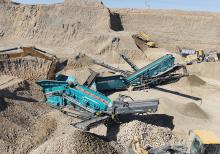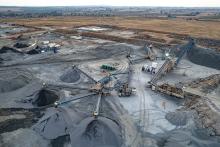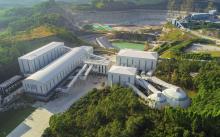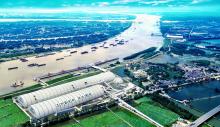
A kettle partly made with purple sand mud is among ceramics in a special exhibition building within the grounds of Huzhou Xinkaiyuan Crushed Stones Company’s quarry (Xinkaiyuan Quarry) in Huzhou, a city 150km north-west of Shanghai in the north of Zhejiang province. Purple sand mud and other mud generated by production at Xinkaiyuan Quarry has been used to make many other ceramics onsite thanks to the quarry’s kiln. The ceramics are sold to customers all over China and are an example of why Xinkaiyuan is known as a Chinese green quarry. Indeed, in 2010 the site, managed and operated by Huzhou Xinkaiyuan Crushed Stones (HXCS), a subsidiary of Shanghai Jiangong Construction Materials Company (SJCM), became one of the first quarries in China to be officially recognised by the Chinese government as a green quarry.
“China’s president Xi Jinping said in 2005 that ‘lucid waters and large mountains are invaluable assets.’ Our quarry embodies that sentiment,” explains Zou Caichao, Xinkaiyuan Quarry vice-manager. “Xi made that observation in Huzhou when he was secretary of the Provincial Chinese Communist Party Committee of Zhejiang. Its sentiment has been acted on all over China since he became president.”
Zou says Yao Shao Wue, Xinkaiyuan Quarry’s current general manager and vice president of China Aggregates Association, has been the big driving force in turning the site into a green quarry. “He studied at China University of Mining & Technology and was always interested in green quarrying. He worked for our parent company [SJCM} and was sent here in 2001, initially to do some building materials research. He stayed and worked his way up to become deputy quarry chief in 2007, with the green quarry upgrade starting the following year. He was then promoted to site general manager in 2013.”
Opened in 1995 after the merging of two smaller HXCS quarries, Xinkaiyuan Quarry currently employs more than 400 staff. The site produces four million tonnes a year of andesite aggregates and manufactured sand, up from 1.5mn tonnes/year produced in the quarry’s early years. The quarry can produce material between 4pm and 8am, six days a week (Monday-Saturday). However, production hours are restricted by local government regulations. Hours outside the permitted 4pm to 8am production window are dedicated to machine and site maintenance. HXCS is licensed to quarry at the Xinkaiyuan site until at least 2035.
A total of 18 different aggregate products and manufactured sand (classified in China as -4.75mm product) are produced at the quarry – with 5-10mm and 10mm-20mm-sized aggregate the most popular and commanding the highest sales price.

To make its aggregates and manufactured sand products, the quarry uses a Lippman 5628 jaw crusher, Terex MVP 450 and Terex MVP 550 cone crushers, a vertical shaft impactor (VSI), and a washing plant from Chinese firm NKM (Nanchang Kuangshan Machinery Company). For loading and hauling work, the quarry uses eight 2018-purchased fully-electric-drive Microvast rigid haulers and six Volvo crawler excavators. Quarry-face blasting to gain aggregates material takes place every two days. Blasting noise is limited and quality enhanced thanks to a bespoke ‘Middle & Deep Hole Blasting’ solution developed by the quarry in co-operation with Nanjing University, China University of Mining & Technology in Xuzhou, and Shanghai Jiao Tong University.
“When we blast, we use water mist to suppress the dust, and our materials production facility is completely enclosed,” says Zou. “Any dust generated in production is sucked into a giant bag, with particles above 0.075mm extracted by a hydracyclone and stored in a tank prior to being used to make manufactured sand. We also reuse the water mist after its been processed in a purpose-built onsite facility. In addition, we use soundproof panels to reduce production noise.”
The andesite aggregates at Xinkaiyuan Quarry have been used to help build many famous Shanghai sites including Shanghai Pudong Airport, Shanghai Tower, Oriental Pearl TV Tower, and Nanpu Bridge, a giant 7km-plus, cable-stayed bridge over the Huangpu River linking Puxi and Pudong. The quarry also supplied aggregates for the 2007 high-speed upgrade of the Shanghai-Hangzhou rail line.
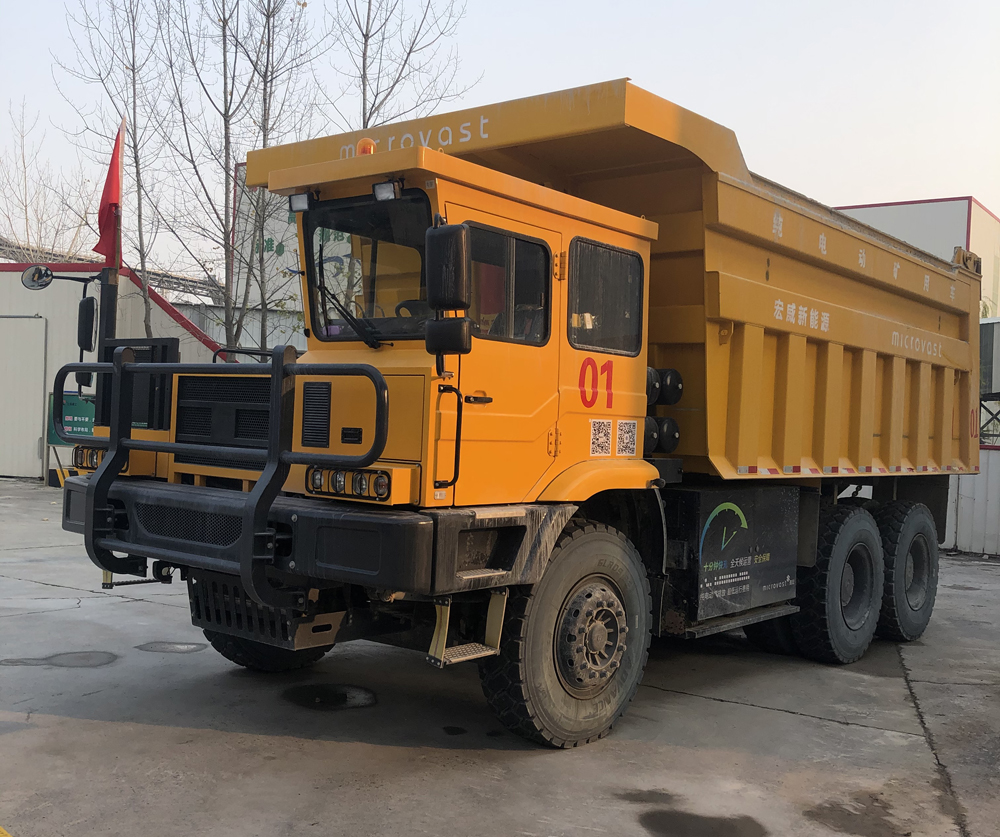
A common material in Zhejiang province, andesite aggregates are high-quality aggregates used in concrete making. Indeed, since 2017, Xinkaiyuan Quarry has also operated six concrete plants which produce up to two million m³ of concrete a year.
Although Xinkaiyuan Quarry had elements of a ‘green quarry’ as far back as 2003, a major increase in its green operating practices began in 2008 with the installation of a 1km-long conveyor belt to transfer aggregates and sand material from the quarry to a material-processing yard at a nearby harbour. There, HXCS-appointed contractors use wheeled loaders and crawler excavators to load stockpiled aggregates and manufactured sand products onto boats. Each boat then transfers its up-to-1,400-tonne cargo by riverways to customers waiting with their own or contractor on-highway trucks at various stopping points. After unloading the boat’s cargo into the appropriate trucks, the aggregates and manufactured sand products begin the final leg of their delivery journey.
Xinkaiyuan Quarry is split into four sections, each with a manager responsible for ensuring high environmental and health and safety standards. Dust-level monitoring technology used by quarry bosses is also linked to the Zhejiang government’s environmental health department, which is keen to ensure all quarries and other businesses in Zhejiang province are keeping work-site dust levels within permitted levels. If the quality of air in Huzhou falls below a legal level, local government officials advise that the quarry’s management and materials production stops until air quality improves.
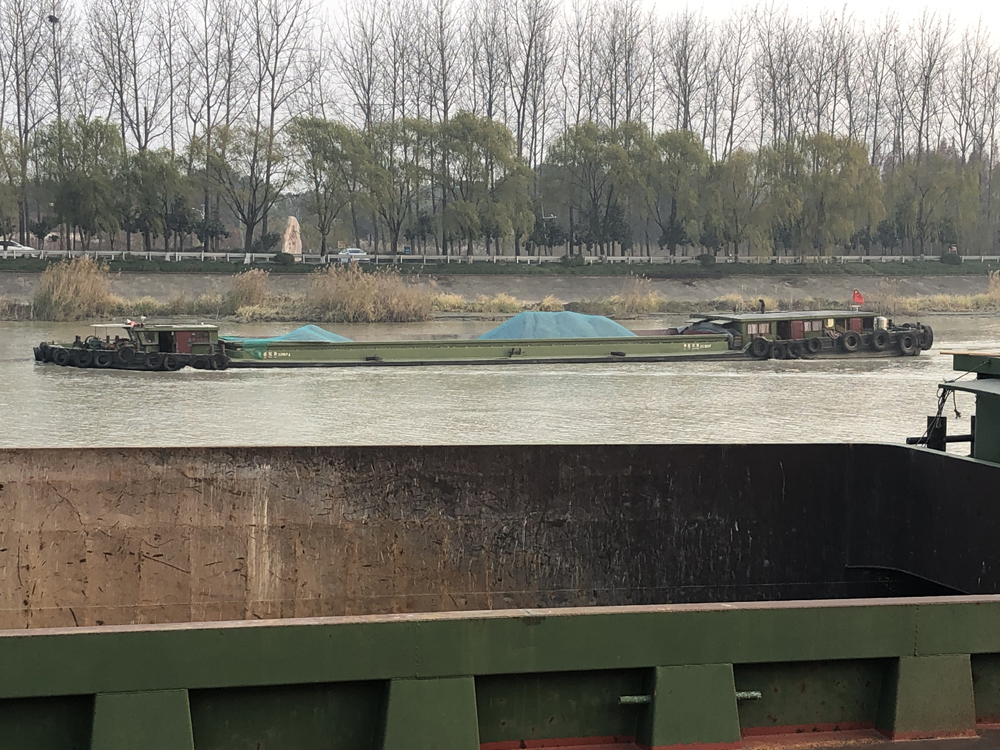
Scores of trees were planted, and other green habitat installed around the edges of Xinkaiyuan Quarry in 2008 in order to encourage biodiversity. It is a decision that has paid off given the abundance of wild animals and insects found onsite. The sensitive replanting of trees to allow for previously unworked areas of the site to be quarried is another feature of the quarry’s green focus.
As well as the quarry’s mud being used in ceramics created onsite, cake generated by the materials washing plant is used to help make bricks for local construction works. Chickens, ducks, pigeons and fish are bred onsite to feed quarry staff. Staff also have access to an onsite sports park, with basketball and table tennis the most played games.
Furthermore, a new building materials research centre in the quarry is due to open before the end of 2020. Research is already being conducted onsite into using production waste to create ceramic foam tiles for insulation and decoration.
HXCS also donates funds to local Huzhou schools and has supported relief work following natural disasters that have affected the city and wider parts of Zhejiang province.

Xinkaiyuan Quarry’s exhibition building includes a large model of HXCS’s plans to modernise the site. It includes a state-of-the-art production factory, homes for quarry workers and other local people, parkland and lakes. HXCS is currently in talks with Zhejiang government authorities about how and when the plans can be implemented.
Given its eco-minded operation and its management’s ambitious site development plans, it is no surprise that Xinkaiyuan Quarry has won a variety of national and regional business worker and environmental best practice awards. In 2017, Xinkaiyuan won High Quality Aggregates Awards and Innovation Enterprise Awards in the second National Aggregates Competition held by China Aggregates Association and Beijing University of Civil Engineering and Architecture. In 2019, several new Xinkaiyuan-utilised technologies were listed in the Catalogue of Advanced and Applicable Technologies for Mineral Resource Conservation and Comprehensive Utilisation issued by the Ministry of Natural Resources. This included technology for the efficient recovery of fine sand and fine powder, wastewater recycling technology, production technology for manufactured sand, digital intelligent blasting technology for open pits, and an intelligent monitoring system for mobile equipment in mining.
Such is the rapid progress with which the Chinese government-led and national aggregates industry-supported green quarry revolution is being executed in China, that the abundance of eco-friendly working practices evident at Xinkaiyuan Quarry is set to become the norm at quarry sites across the vast country within the next five years. Given that Chinese annual aggregates demand is 20 billion tonnes a year – around 40% of the world’s annual demand – the scale of the country’s green quarry uptake is already attracting significant global attention. I look forward to returning to Xinkaiyuan Quarry to see what is already being described as ‘China’s tomorrow green quarry today’ becoming even more cutting edge in its embrace of ecologically-minded, large-scale aggregates production.

